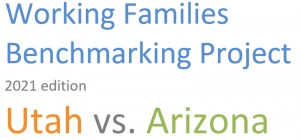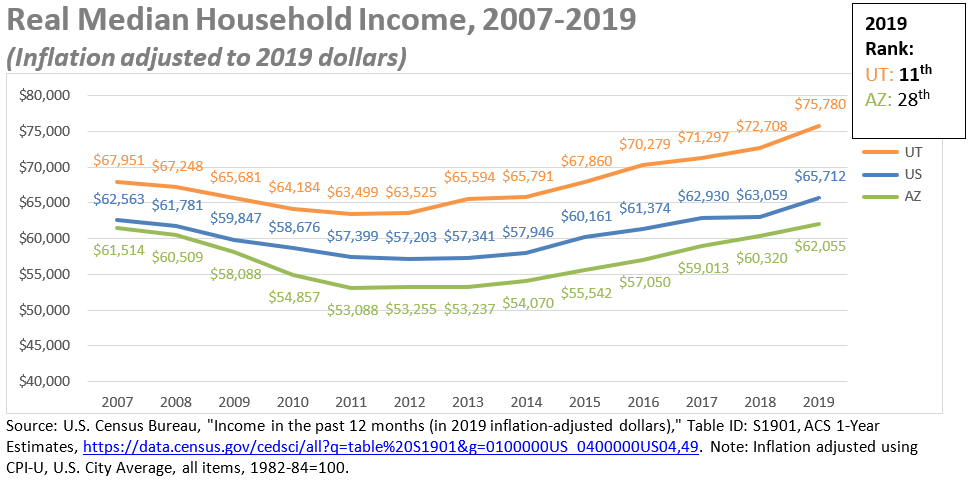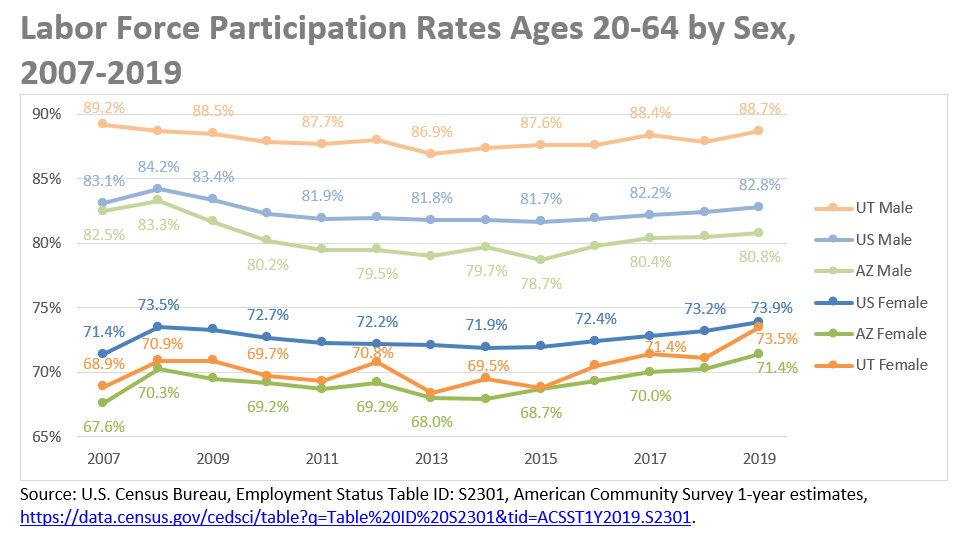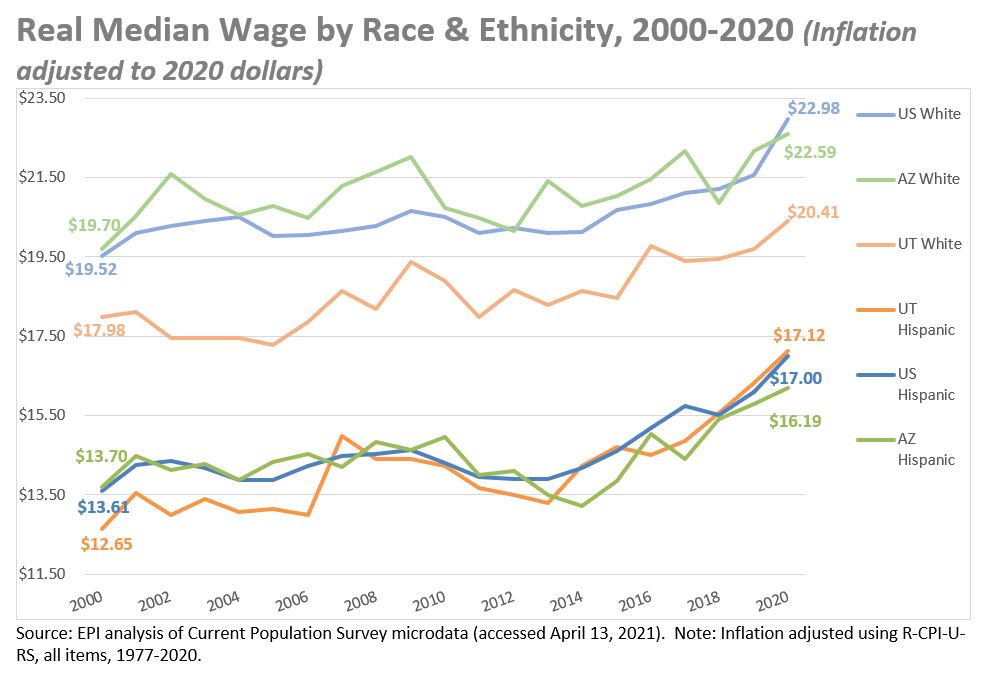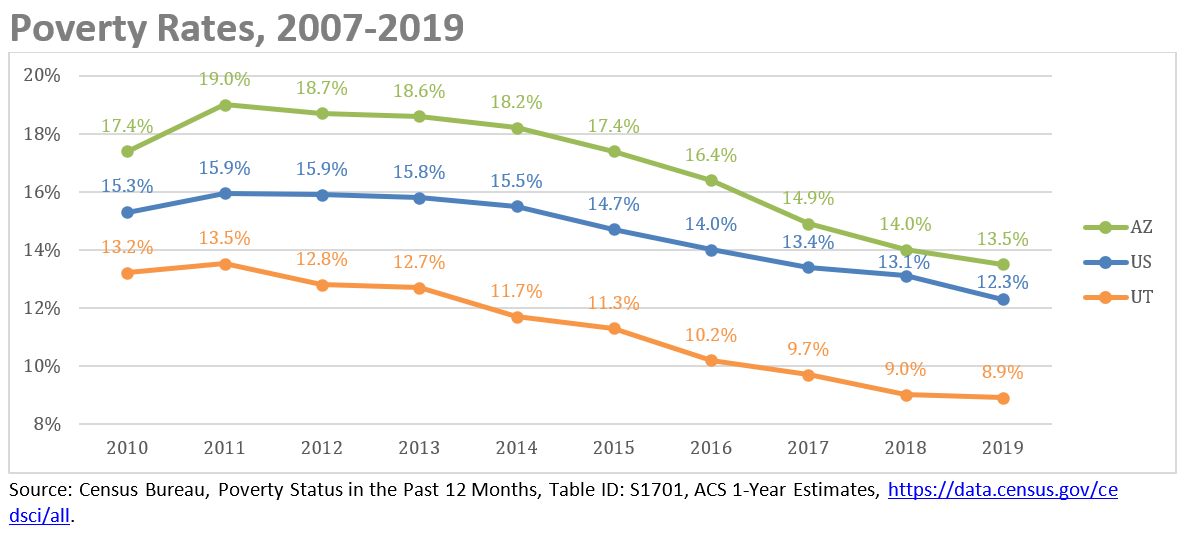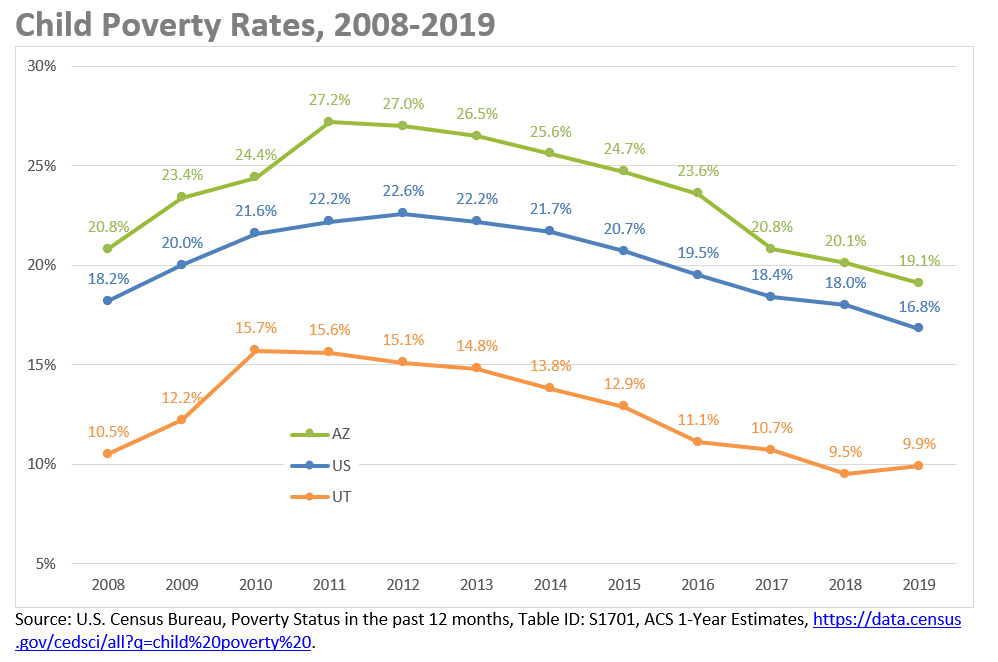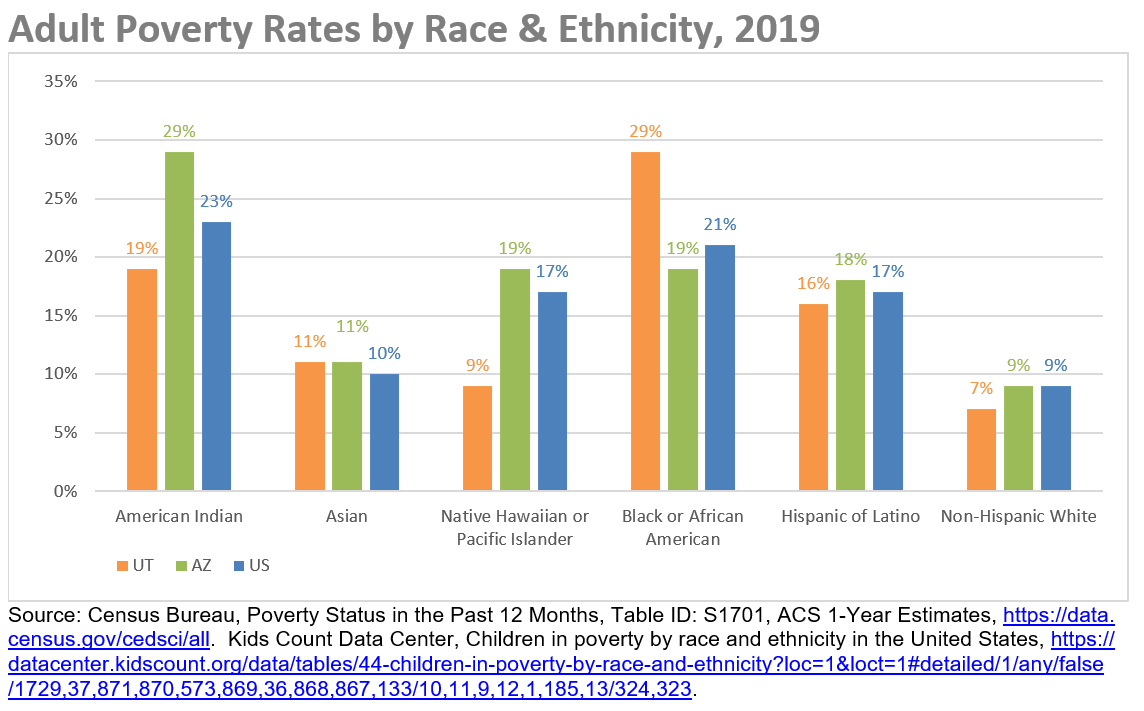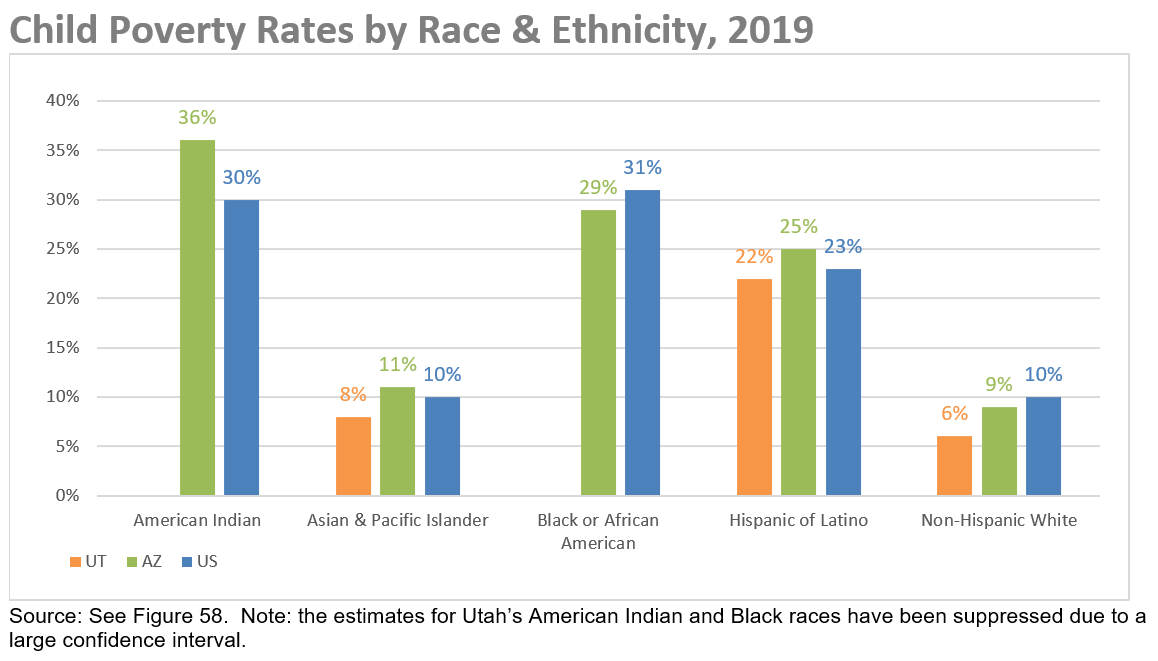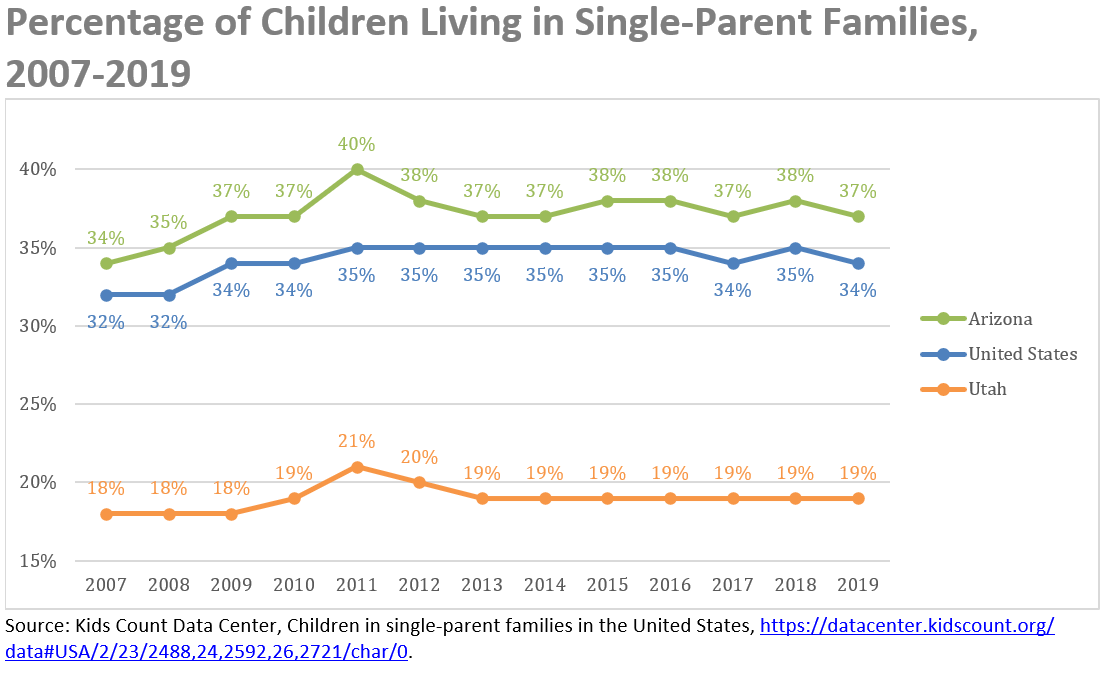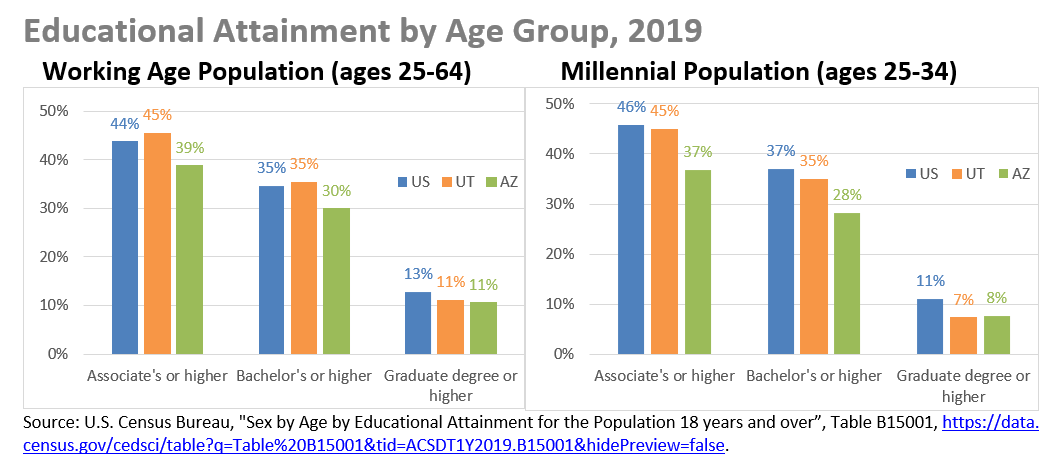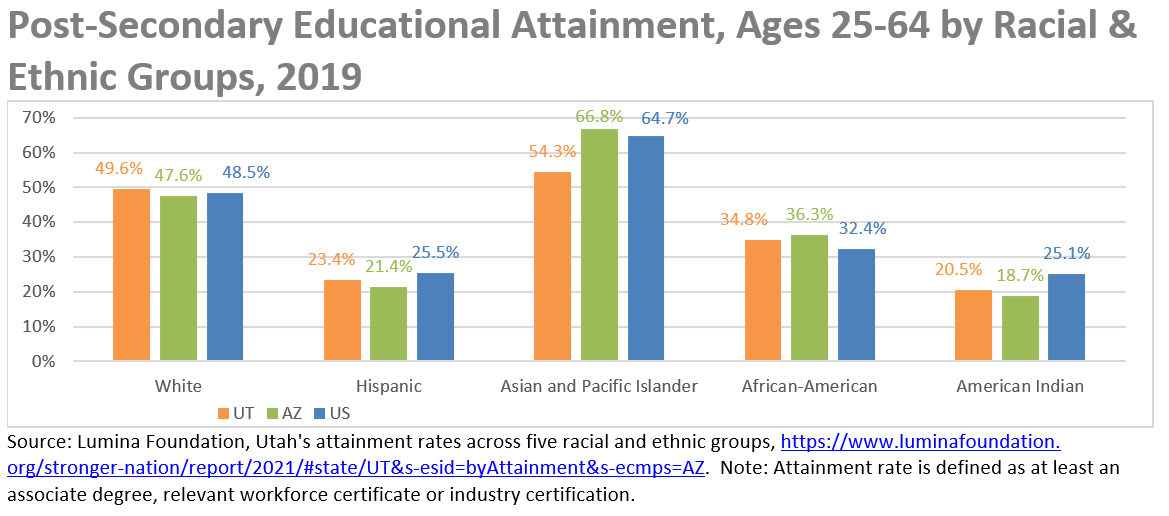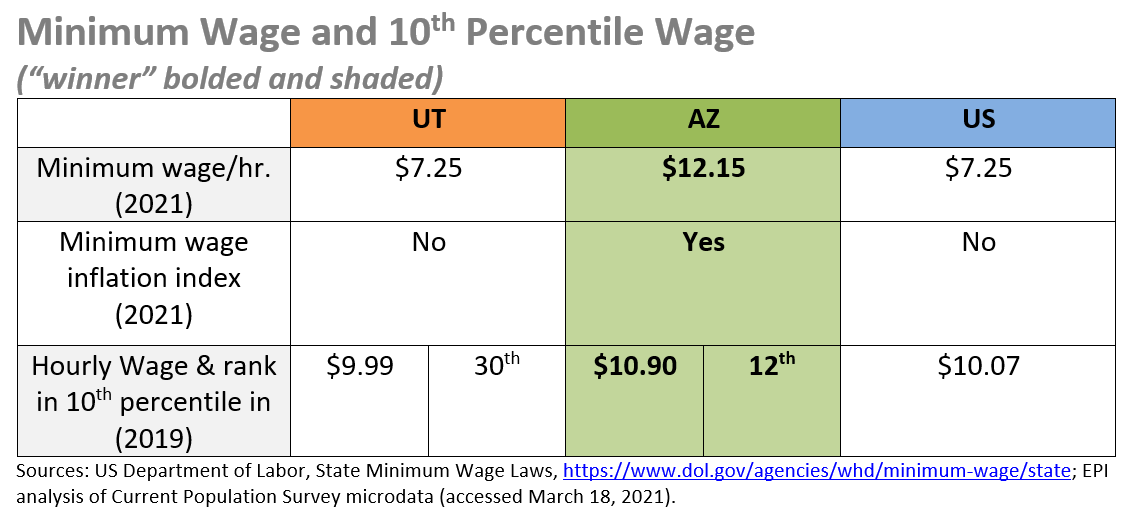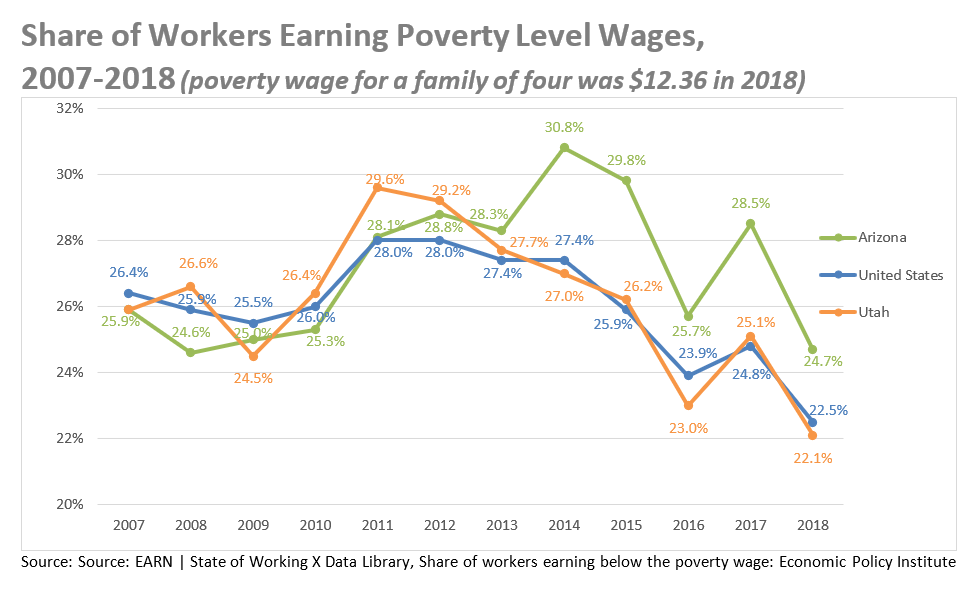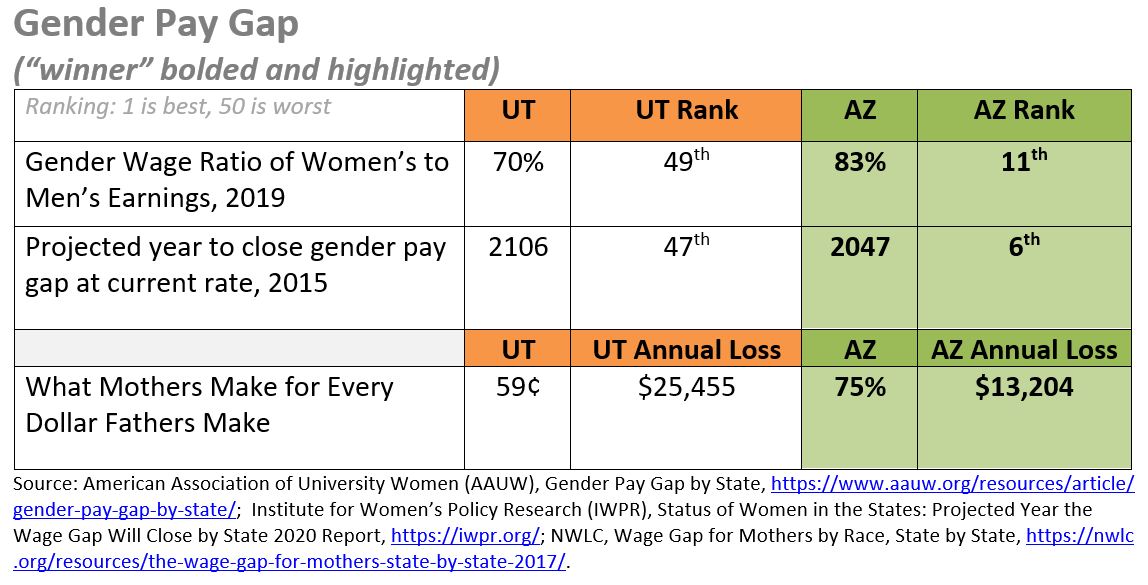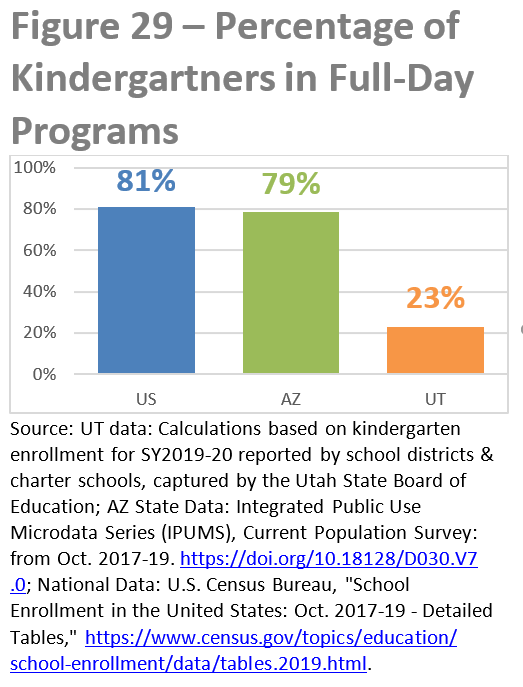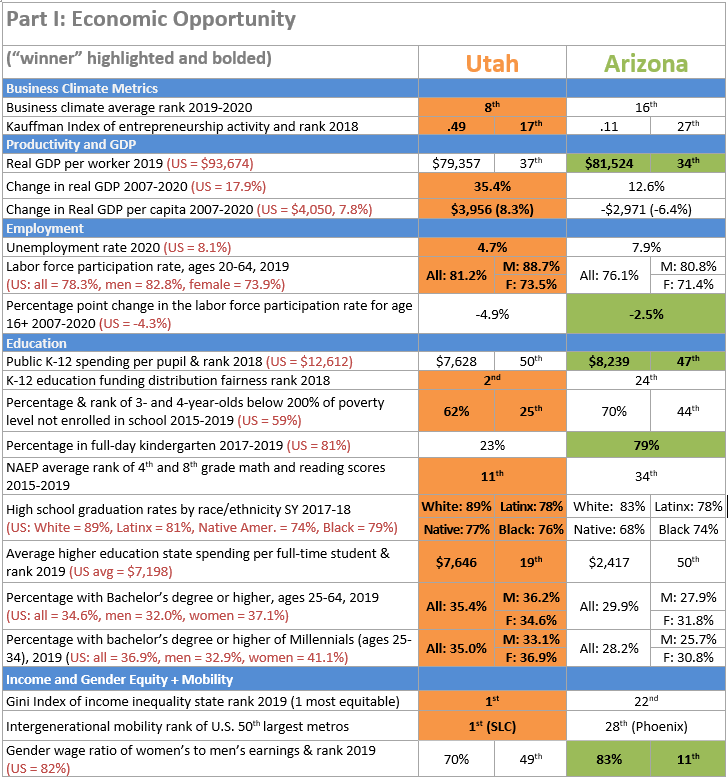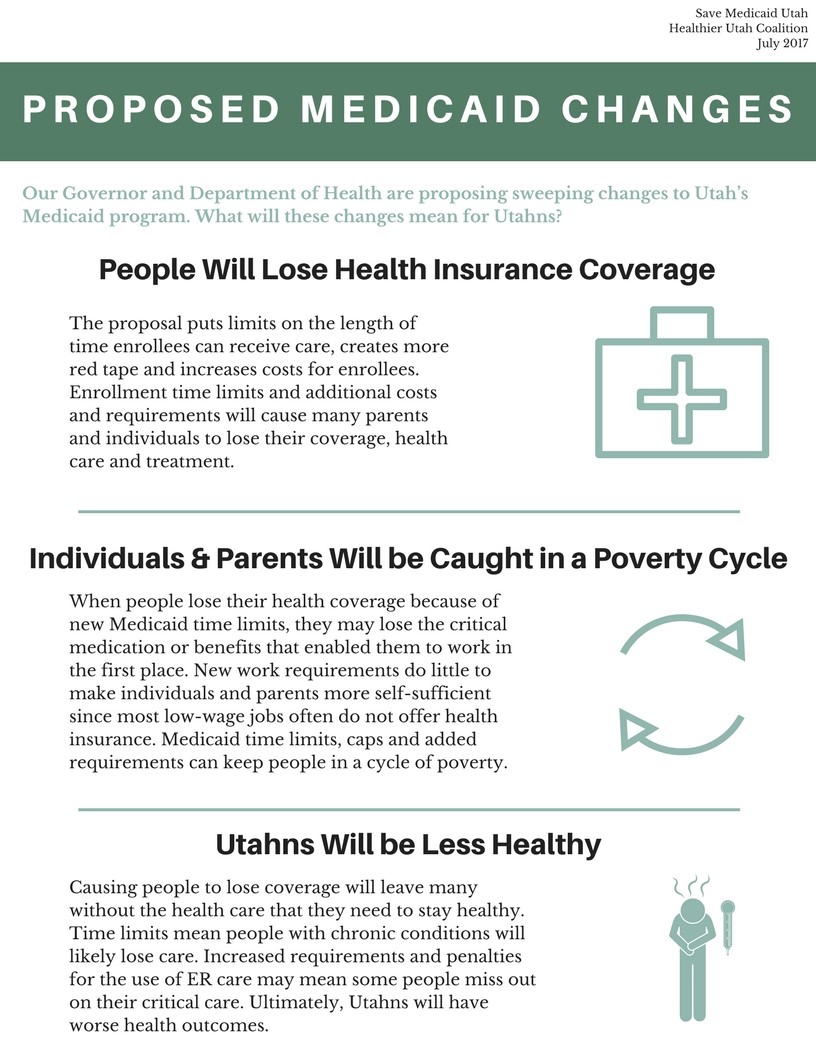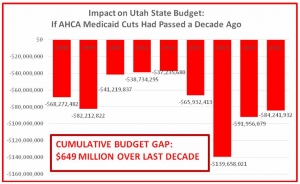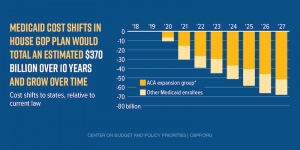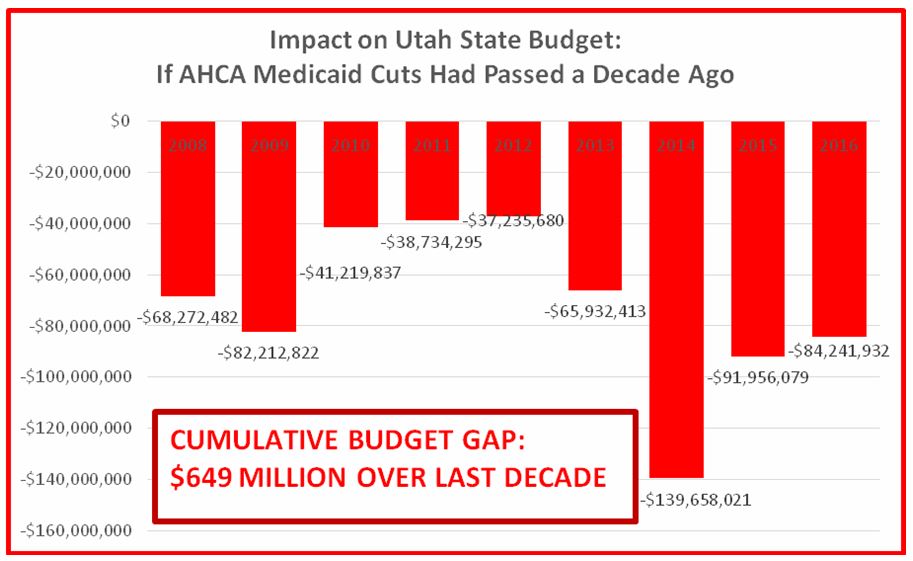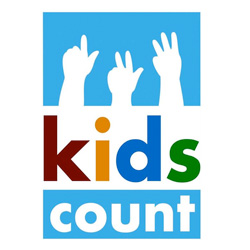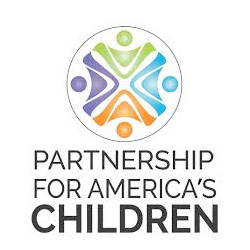State Policy
New Economic Benchmarking Report Finds Utah Ahead of Arizona in Most Key Metrics of Economic Opportunity and Standard of Living
Salt Lake City, May 6, 2021 - Voices for Utah Children released today the fourth in its series of ![]() economic benchmarking reports that evaluate how the Utah economy is experienced by median- and lower-income families by benchmarking Utah against another state. This year's report, authored by Taylor Throne and Matthew Weinstein with support from interns from the University of Utah Department of Economics, compares Utah to its southern neighbor, Arizona. Utah and Arizona have a nearly identical proportion of working age adults (18 to 64 years), increasingly diverse populations, and ready access to outdoor recreational opportunities here in the American Southwest. The findings in this year's report shed light on some of Utah's greatest strengths as well as where we can continue to improve.
economic benchmarking reports that evaluate how the Utah economy is experienced by median- and lower-income families by benchmarking Utah against another state. This year's report, authored by Taylor Throne and Matthew Weinstein with support from interns from the University of Utah Department of Economics, compares Utah to its southern neighbor, Arizona. Utah and Arizona have a nearly identical proportion of working age adults (18 to 64 years), increasingly diverse populations, and ready access to outdoor recreational opportunities here in the American Southwest. The findings in this year's report shed light on some of Utah's greatest strengths as well as where we can continue to improve.
Voices for Utah Children's State Priorities Partnership Director Matthew Weinstein commented, "The main takeaways from this report and the others in the series are that Utah's economic successes put us in a position to make the new upfront investments we need to make now -- in education, public health, poverty prevention, and closing majority-minority gaps -- so that we can achieve our true potential and follow in the footsteps of states like Colorado and Minnesota that have become high-wage states and achieved a higher standard of living, and do it in such a way that all our children can have a better future."
The report release presentation took place online and can be viewed at https://fb.watch/5jZBVxpKOY/ . The presenters included both Taylor Throne and Matthew Weinstein as well as a special guest, David Lujan, Director of the Arizona Center for Economic Progress, to share the Arizona perspective on the report.
Utah's Top Economic Advantages: Hard Work & Strong Families Allow Utah to Enjoy High Household Incomes and Low Poverty
Utah enjoys a higher real median household income than Arizona, ranking #11 nationally, although there are significant gaps between the median wage of different racial and ethnic groups. Utah's higher incomes are due largely to our high labor force participation rates and our preponderance of two-worker (often two-parent) households.
Utah Has Lower Poverty Rates Overall But Still Suffers from Large Racial/Ethnic Gaps
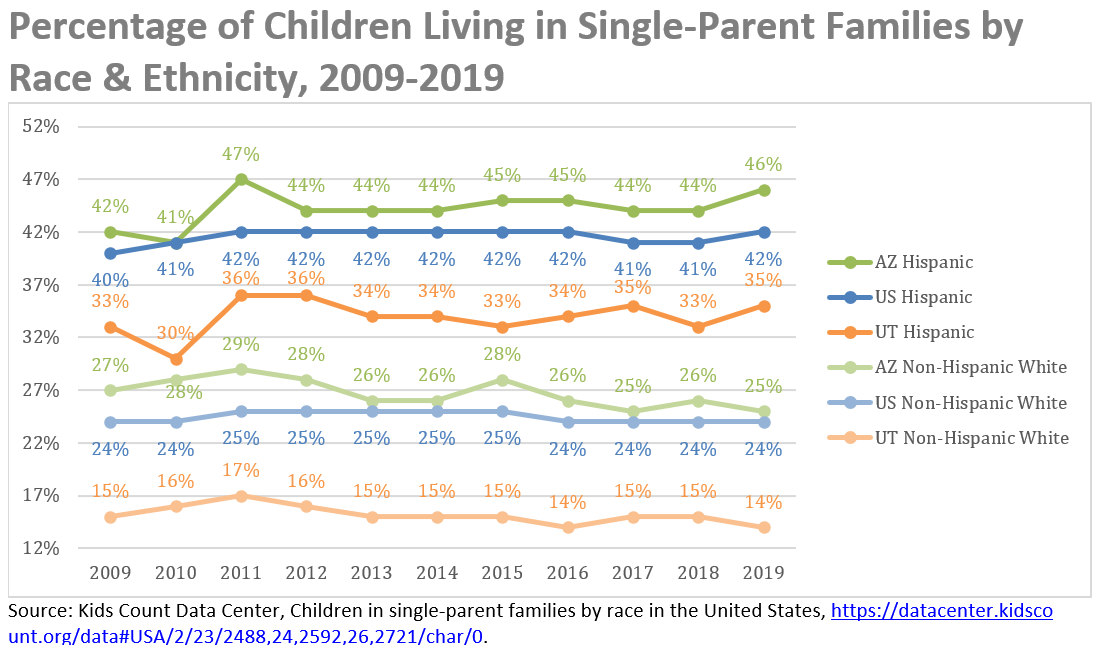
Educational Attainment: Utah Ahead of Arizona But Falling Behind the Nation
The charts below from our latest benchmarking report compare Utah, Arizona and the nation as a whole on educational attainment. Historically Utah was well ahead of the nation, but more recently evidence has mounted that the younger generation of Utahns is not keeping up with the nation's gains at the level of higher education. Moreover, there are stark racial/ethnic gaps in both states and the nation as a whole.
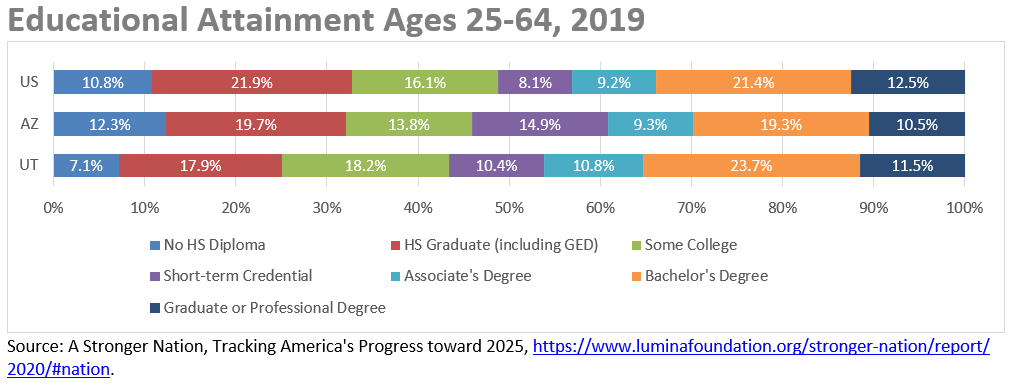
Utah's high school graduation rates are at or below national averages for most racial/ethnic categories, including our two largest groups, Whites and Latinos.
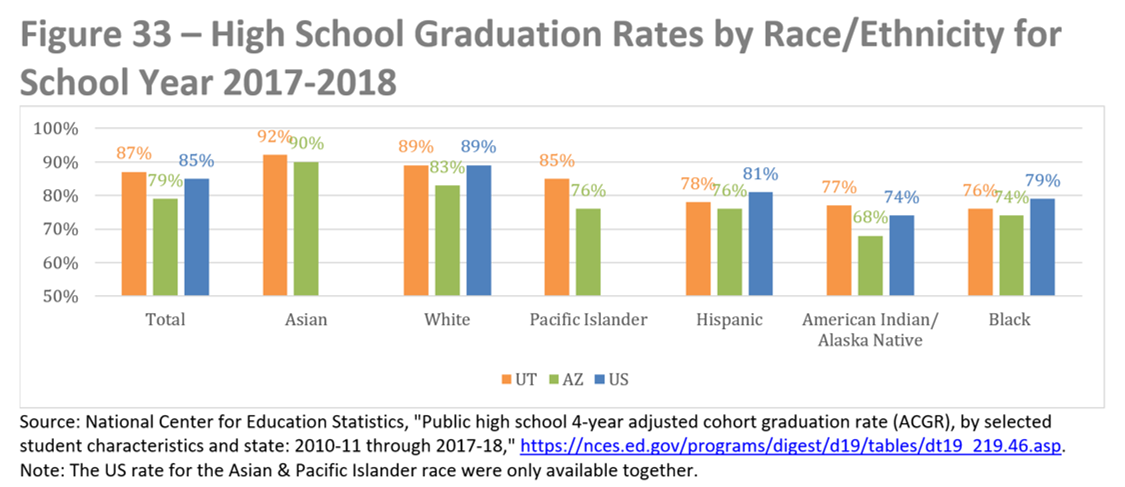
We're also very concerned that Utah's gap between high school graduation rates for Whites and Latinos is larger than nationally.
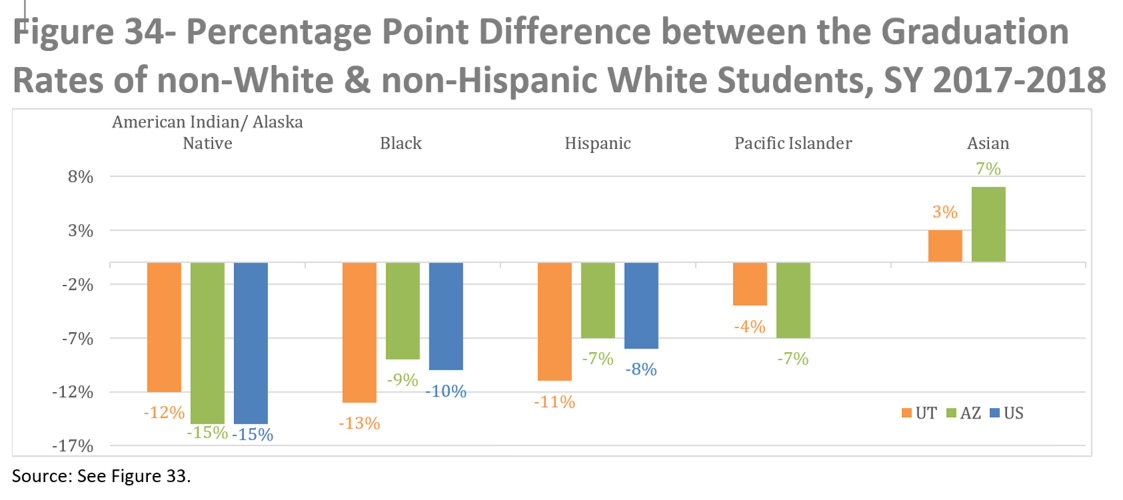
The chart below illustrates the way that Utah's younger generation of adults has fallen behind the higher education attainment of the Millennial generation nationally.
Can Utah Learn Any Lessons from Arizona's Strengths?
Besides Arizona's #11 rank for equal gender wage ratio (while Utah ranks #49), Arizona has more of its children in full-day kindergarten, has a lower 10th percentile hourly wage, and higher productivity. Arizona's higher 10th percentile hourly wage is likely due to their higher minimum wage, although they do have more people earning poverty level wages overall. Meanwhile, Utah has fewer people earning poverty level wages overall, but those at the 10th percentile for hourly wages earn less than their Arizonian counterparts.
Summary of Key Findings
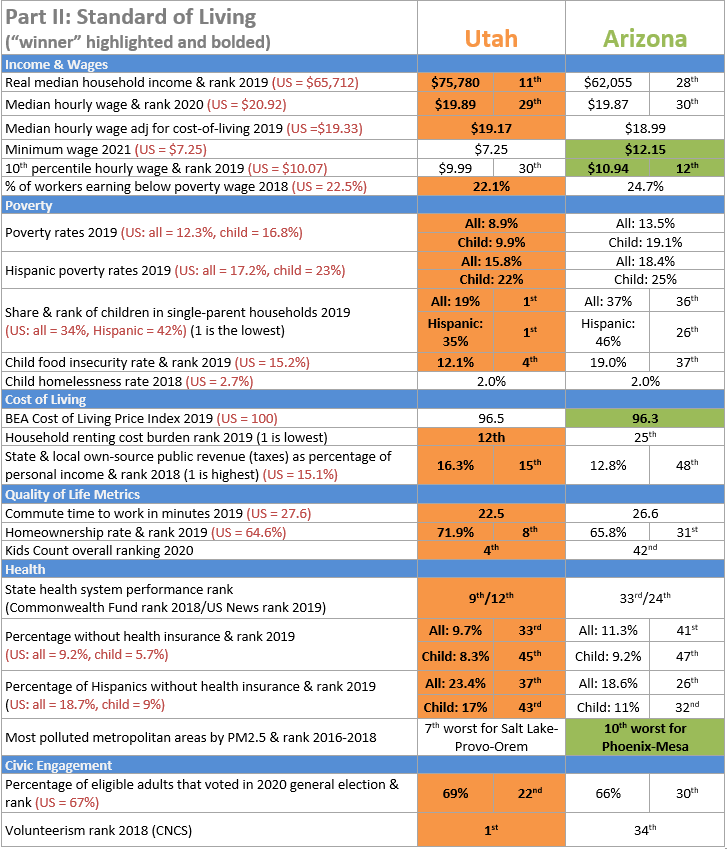
The full 56-page report is ![]() available here as a pdf download.
available here as a pdf download.
Policy Implications
Racial/Ethnic Gaps
Racial and ethnic gaps remain a major challenge in the nation overall, and Utah and Arizona are no exception. Disparities in Utah between minority racial & ethnic groups compared to their White non-Hispanic peers are evident in high school graduation rates, wages, gender pay gaps, poverty rates, and uninsured rates. Addressing these gaps through an upfront investment in education would likely increase educational attainment, wages, and standard of living overall and would therefore contribute to reducing racial and ethnic gaps in the future.
The Link Between Education and Income
The link between education and income is well-established. States with higher education levels generally have higher levels of worker productivity, wages, and incomes. In the current comparison with Arizona, Utah’s higher education levels make for higher levels of wages and income. The lesson for Arizona would be raise education levels to raise the state’s standard of living. The same applies to Utah, where the Legislature has struggled to turn seemingly large dollar increases in education funding every year into increases in real per-pupil investment sufficient to get Utah out of last place in the national ranking.
The latest data from the Census Bureau reports that Utah remains in last place in per-pupil education investment at $7,628, with Arizona only slightly better at $8,239 and 47th in the nation (for FY 2018). While Utah has done well for its meager investment levels, achieving impressive gains in educational performance as measured by NAEP 4th and 8th grade math and reading scores (see Figure 31, page 25), will we be able to continue to advance while remaining in last place?
While Utah “does more with less” in education compared to other states, we have growing challenges to address. Utah has racial/ethnic education gaps which are larger than the national average, for example for Hispanic and American Indian high school graduation rates (see Figure 33, page 26). Utah’s pupil-to-teacher ratio is 22.9, ranking 48th while the national average is 16 (see Figure 22, page 21). Moreover, Utah teacher pay has also fallen over the past 50 years by 1.8% while nationally teacher salaries have increased 6.7% (see figure 24, page 22).
At the college level, Utah historically was always ahead of the national average for attainment of bachelor’s degrees and above. But Census data show Utah’s lead shrinking relative to the nation with each successive generation, to the point now that Utah millennials (ages 25-34) are behind their peers nationally, despite relatively generous state support and low tuition levels.
Can Utah Become a High-Wage State?
For many years, economists have debated whether Utah is a low-wage state, as the Utah Foundation discussed in their 2008 report, “Is Utah Really a Low-Wage State?”[1] That report argued that our seemingly low wages were explained by our younger demographic profile and lower cost of living. While this report does not examine how wages intersect with age demographics, Utah ranks 29th in median hourly wages, compared to 41st in 2004 (see chart below). When adjusted for our low cost of living, Utah’s median hourly wage in 2019 was $19.17, just 16 cents lower than the national level. These data seem to demonstrate that Utah has gone from being a low-wage state a generation ago to middle-wage status today, a considerable accomplishment.

One question Utah leaders may now wish to consider is, is that good enough? Should we declare, “Mission Accomplished”? Or is Utah in a position, like Colorado and Minnesota before us, to become, over time, a high-wage state and set our sights on taking the necessary steps today to achieve that goal over the years and decades to come?
Similarly, how do we include those earning the lowest wages in the gains Utah has made and will potentially make in the future? Utah is not even a half percentage point lower than the national share of workers earning poverty level wages (see Figure 55, page 38) and lags behind the nation’s 10th percentile wage, ranking 30th (see Figure 54, page 37). Even as the state with the lowest income inequality ranking in the nation (see Figure 45, page 31), Utah suffers from a tremendous gap between low-income workers and the rest of the income scale.
The main lesson that emerges from the Working Families Benchmarking Project reports comparing Utah to Colorado, Minnesota, Idaho and now Arizona is the following: Higher levels of educational attainment translate into higher hourly wages, higher family incomes, and an overall higher standard of living. The challenge for policymakers is to determine the right combination of public investments in education, infrastructure, public health, and other critical needs that will enable Utah to continue our progress and achieve not just steady growth in the quantity of jobs, but also a rising standard of living that includes moderate- and lower-income working families from all of Utah’s increasingly diverse communities.
MEDIA COVERAGE OF THE BENCHMARKING PROJECT:
Facebook Live Event discussing the report overall joined by David Lujan, Director of Arizona Center for Economic Progress at Children's Action Alliance: https://fb.watch/68E_JarLMT/
Facebook Live Event focusing on women in higher education, the gender pay gap, and income equality with panelists: Dr. Susan Madsen, Founder and Director of the Utah Women & Leadership Project; Marshall Steinbaum Ph.D., Associate Professor at the University of Utah's department of Economics; and Gabriella Archuleta JPP MPP, Policy Analyst with YWCA Utah. https://fb.watch/68FoEVvGwY/
Facebook Live Event focusing on Utah's economic success and economic development strategy with panelists: Howard Stephenson MPA, former Utah Senator; Phil Dean MS MPA, public finance senior research fellow at the Gardner Institute; and Thomas Maloney PhD., Professor, Department of Economics, University of Utah. https://fb.watch/6r25O5rdDd/
Facebook Live Event focusing on education in Utah from pre-school to higher education, focusing on educational attainment & closing racial and ethnic gaps with panelists: Carrie Mayne, Chief Economist for Utah System of Higher Education; Andrea Rorrer PhD., Director of the University of Utah's Education Policy Center; and Anna Thomas MPA, Senior Policy Analyst at Voices for Utah Children. https://fb.watch/7iKYaR9Zy4/
What do Utahns Think About the Proposed Changes to Medicaid and PCN? Results of a Statewide Survey
Recently the Healthier Utah Coalition ‘Save Medicaid Campaign’ put together a survey to get public feedback on the Utah Department of Health’s proposed changes to its Medicaid program. The proposed amendments to the Medicaid and Primary Care Network (PCN) included controversial program changes such as lifetime caps on coverage, work requirements, and $25 copays for ‘inappropriate’ use of the ER. The proposed amendments would also eliminate presumptive eligibility in Medicaid and reverse an earlier Department of Health decision to restore comprehensive benefits to 19 and 20-year-old youth.

The Utah Department of Health held two public meetings at its Salt Lake City office in the summer. The Coalition’s survey was an attempt to reach a wider audience across the state, and walk through each amendment for those less familiar with the proposed waiver. We modeled the survey after a similar one developed by fantastic advocates in Kentucky. Survey responses were also sent to the U.S. Department of Health and Human Services, during their federal waiver comment period (if the respondent granted permission).
So, what did we learn?
Over 350 people took the survey. Survey respondents came from across Utah and all walks of life:
- Over half of respondents (58%) reported being either on Medicaid or PCN, or have a family member on Medicaid or PCN.
- The majority of respondents were between the ages of 30- 69.
- Over half of respondents (54%) were working less than 31 hours/ week. They reported working part-time, as a caregiver, or reported being retired, disabled or a student.
- 50% of respondents came from Salt Lake County, followed by Utah (11%), Davis (10%), Weber (8%), Washington (6%), Cache (3%), Iron (2%), and Box Elder (2%). Only six counties did not have any survey respondents: Daggett, Garfield, Juab, Kane, Morgan, and San Juan.
How did respondents feel about the proposed changes?
Overall, the proposed Medicaid changes were very unpopular. The most unpopular changes were imposing lifetime limits on PCN or Medicaid coverage. Interestingly, the option to impose ER penalties had the most support, although the majority of respondents still opposed it.
- 91% were against time limits on coverage
- 75% were opposed to work requirements
- 53% were opposed to ER penalties
- 87% opposed to eliminating presumptive eligibility
- 90% opposed eliminating comprehensive benefits for 19 and 20-year-old’s
A few of the comments from respondents:
“As a care taker for my elderly mother, I have been in this position for nearly a decade and my part time income is always below FPL, yet I cannot get inclusion into PCN because I have no children…. No one seems to be addressing people in my situation at all.”
“I am concerned that my adult daughter with significant health care issues may lose the critical coverage that she needs to sustain quality of life and even life itself.”
“Many of the families I work with cannot afford $25 dollars [for an ER copay]. Paying this much as a co-pay would mean they do not eat.”
“[Without Medicaid] I would have died from cancer by now. I'm 41. I have so many prescriptions for my illnesses, I would be bankrupt and homeless, relying on hand outs. Now I have a part time job, housing I can pay rent and utilities bc my medical is covered. I know hundreds of people in my community who are receiving mental health care like myself. It's the best around. I am grateful daily as I am healthy only bc I have adequate health services. I can't imagine if I didn't. I would suffer severely. Many Utahns are in the same situation.”
For 30 years now, Voices for Utah Children has called on our state, federal and local leaders to put children’s needs first. But the work is not done. The children of 30 years ago now have children of their own. Too many of these children are growing up in poverty, without access to healthcare or quality educational opportunities.
How can you be involved?
Make a tax-deductible donation to Voices for Utah Children—or join our Network with a monthly donation of $20 or more. Network membership includes complimentary admission to Network events with food, socializing, and opportunity to meet child advocacy experts. And don't forget to join our listserv to stay informed!
We look forward to the future of Voices for Utah Children and we hope you will be a part of our next 30 years.
Special thanks to American Express, our "Making a Difference All Year Long" sponsor. 
Congress Missed the Deadline on CHIP: What Does That Mean for Utah Kids? (And what we can do about it)
Tell Congress to Protect Healthcare for Kids: Graham-Cassidy ACA Repeal Bill Threatens the Children’s Health Insurance Program
Utah’s Double Medicaid Threat
At Voices for Utah Children, we are closely following what happens to Medicaid. The majority of Utah’s Medicaid enrollees are kids. CHIP- the Children’s Health Insurance Program- could not exist without Medicaid. Medicaid is the cornerstone for children’s health. All kids need health insurance to be healthy and thrive,
But now Utah’s Medicaid program is under not just one but two threats. There are changes to Medicaid being proposed in Congress at the federal-level, and changes proposed by Governor Herbert and the Department of Health at the state-level.
Trying to understand these different changes and what they mean for Utahns? Here is a quick overview of the federal and state threats:
#1 Federal Cuts to Medicaid and Dismantling the Medicaid Program as We Know It
There are significant threats to Medicaid in the Republicans’ ever-changing ACA repeal efforts. The G.O.P. health care bill proposes massive cuts to Medicaid and a radical restructuring of the Medicaid program. Specifically, Congress has proposed two different state options; both would lead to major changes and cuts to the Medicaid program. 1) States can opt to cap funding through a per enrollee or per capita amount. This cap option would allow for the program to grow if new people enroll, but would limit the federal dollars available for states to meet demand and program growth. 2) Or states can opt for the block grant option, which is essentially a ‘lump sum’ amount. Under this option, even fewer federal dollars flow into the state’s Medicaid program, but the state has greater ‘flexibility’ to cut people or benefits from the program. Under the current Senate bill, certain children with special health care needs are exempt from the per capita cap option and all children are exempt from the block grant. Yet as many others have pointed out, these are not sufficient ‘fixes’ to the problem, since we know that children need healthy parents to thrive. Moreover, the bill still limits available state resources overall, which means vulnerable populations including children, seniors and people with disabilities, will be forced to compete for limited state dollars.
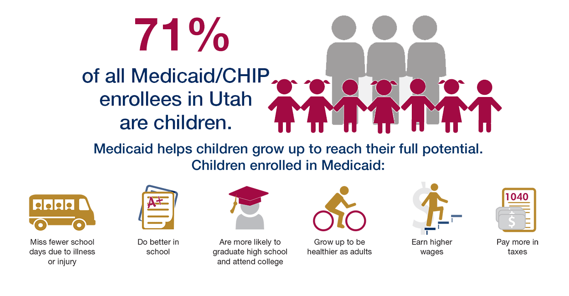
But unfortunately, those are not the only threats to Medicaid...
#2 State Changes to the Medicaid Program through a Waiver Request to the Federal Government: People Will Lose their Health Coverage
While Congress is considering Medicaid cuts, Utah’s state Department of Health is also proposing some unprecedented administrative changes to the Medicaid program. The Department wants to move forward with these changes regardless of what happens at the federal level.
The Utah Department of Health is planning to submit a request, or waiver, to the federal government to make the changes. States are not required to change their program- most aren’t. But a few states like Utah are seeking to increase restrictions and requirements in their Medicaid program. Why are states doing this now? Previous administrations did not allow for these changes. But the new Trump administration has indicated that they are open to increased Medicaid restrictions.
Utah is proposing several changes that will cause enrollees to lose care and more people to lose coverage. Learn more about the full scope of the changes and how to take action. Some changes include:
1) Health insurance time limits: The Department is proposing to limit the length of time a parent or individual can receive coverage through the Primary Care Network (PCN), or the time an adult without children can receive Medicaid. Even if the parent is working and on PCN, they will lose coverage after 5 years. This will be particularly harmful for those with chronic conditions or mental health needs who require some medication, but do not qualify for disability Medicaid.
2) Work requirements for Primary Care Network (PCN) enrollees: Work requirements mean more red tape and administrative requirements for enrollees. Added administrative requirements increase the likelihood that someone will miss a deadline or forget paperwork, and then lose their coverage entirely. What’s more, we already know that work requirements are not an effective way to improve coverage.
3) Penalties for non-emergency use of the ER: If an individual or parent goes to the ER for a non-emergency purpose, he or she will be charged a $25 penalty. The goal of this increased penalty is to decrease state costs. Unfortunately, many advocates believe this will simply deter vulnerable populations from accessing the care they need. What’s more, the Department is increasing penalties without any additional support for enrollees to receive care management or patient navigation support.
The Department of Health is currently accepting comments and public feedback about these proposed changes. Share your comments online by July 20th.
Or attend an upcoming public hearing on July 10th.
2017 Measures of Child Well-Being in Utah and the National Annie E. Casey Data Book Released
Voices for Utah Children recently released our annual data book Measures of Child Well-Being in Utah along with the National Annie E. Casey Data Book. These annual publications provide citizens, advocates, community leaders and policymakers with the most timely and comprehensive data regarding the health and well-being of Utah's children. Combined, these publications provide a look at how Utah compares to the rest of the nation, as well as a more in-depth picture of child well-being at the county level. Used together, these data books are a reliable source for accurate information that can help shape priorities and policies to improve the well-being of Utah's children.
If we had a crystal ball that told us how our children would be doing two, five, or ten years down the road we could make thoughtful, calculated policy decisions. To make plans for an increasing number of children it is imperative that we have good data on how children have fared in the past and how that compares to today. That is one of the basic premises of the KIDS COUNT Project - provide accurate, accessible data to make sure the future that is “just around the corner” is a positive one for all of Utah’s children.
One of the things we know about children in Utah is that there will be more of them in the future. Population estimates from the U. S. Census Bureau indicate that the number of children in Utah in 2011 was 882,354. By 2015 that number had risen to 912,496. By 2050, the Utah Governor’s Office of Planning and Budget projects that Utah’s child population will be well over a million at 1,388,651. With an expanding child population, it is important to understand what the needs are today so we can plan for tomorrow. So how are the children doing?
According to the National Data book, improvements have been achieved across almost all key areas of well-being for children. The state is ranked seventh nationally in overall child well-being, landing in the top ten for both child economic well-being and family and community context. This data points to the fact that children in Utah are benefiting from state policies aimed at helping them succeed.
Boosted by the Children’s Health Insurance Program (CHIP), Medicaid and a push for outreach, Utah has dramatically increased access to health insurance for children: Between 2014 and 2015, 20,000 fewer children lacked coverage. This progress has helped Utah recover from a fall to 27th place in child health last year, and the state now ranks 19th nationally. However, at 7%, the percentage of children without insurance is still above the national average and more can be done to provide kids with the health and security proven to better position them for success later in life.
The annual KIDS COUNT Data Book uses 16 indicators to rank each state across four domains — health, education, economic well-being and family and community — that represent what children need most to thrive. Utah ranks:
- 5th in economic well-being. At 20 percent, Utah has one of the nation’s lowest percentages of children who have no parent with full-time, year-round employment. However, the percentage of children living in poverty remained unchanged at 13 percent between 2014 and 2015.
- 15th in education. The state saw decreases in the percentage of eighth graders scoring below proficient in math, fourth graders who were below proficient in reading, and in the number of 3- and 4-year-olds not attending school.
- 3rd in the family and community domain. Just 5 percent of children in Utah live in high-poverty areas, which is well below the national average of 14 percent. The teen birth rate has fallen to 18 births per 1,000 females.
- 19th in health. The percentage of teens abusing drugs and alcohol remained at 5 percent for the third consecutive year. The child and teen death rate also hovers at the national average of 25 deaths per 100,000 children.
Along with critical gains in health, the 2017 Data Book shows that investments in early childhood education are paying off. Utah exceeds the national average for its percentages of fourth graders meeting proficiency in reading, eight graders meeting proficiency in math and high schoolers graduating on time. Utah also saw a decrease in the percentage of children ages 3 and 4 who are not in school, a trend that is likely to continue as positive policies such as SB 101 — which makes it possible to offer scholarships for quality preschool to families living in intergenerational poverty — are implemented. Positive policies such as this will have profound impacts on children’s lives.
Supplementing the National Data Book is Measures of Child Well-Being in Utah, an annual publication from Voices for Utah Children that presents county-level data to local policymakers and planners. Measures of Child Well-Being in Utah also provides information at the state-level on racial and ethnic disparities and it highlights emerging trends. In Utah, child death rates, suicide rates, and chlamydia rates are all on the rise. While the percentage of uninsured kids has been improving, this indicator will be affected by future policy decisions around Medicaid and CHIP.
Measures show that the percent of kids in poverty in Utah has declined slightly but there are differences depending on where you live and if you are a child of color. Statewide, almost 13% of kids live in poverty, around 116,000 children. However, 25% of Latino/a children live below the poverty level and county poverty levels range from a low in Morgan of 5.3% and a high of 31.9% in San Juan County.
Education data in Measures indicates that, once again, more children are enrolled in our schools than the year before. From Fall of 2015 to Fall of 2016 enrollment increased by 11,680 students. And this yearly increase is a common occurrence.
The Utah KIDS COUNT Project is funded by the Annie E. Casey Foundation whose primary mission is to foster public policies, human-service reforms, and community supports that more effectively meet the needs of today’s vulnerable children and families. By providing policymakers and citizens with benchmarks of child well-being, KIDS COUNT seeks to enrich local, state, and national discussions of ways to secure better futures for all children. It is intended to gauge the seriousness of the problems facing children, and to guide the policy trends and goals on behalf of children. Using these two publications together, KIDS COUNT can measure child outcomes and contribute to public accountability for those outcomes.
For 30 years now, Voices for Utah Children has called on our state, federal and local leaders to put children’s needs first. But the work is not done. The children of 30 years ago now have children of their own. Too many of these children are growing up in poverty, without access to healthcare or quality educational opportunities.
How can you be involved?
Make a tax-deductible donation to Voices for Utah Children—or join our Network with a monthly donation of $20 or more. Network membership includes complimentary admission to Network events with food, socializing, and opportunity to meet child advocacy experts. And don't forget to join our listserv to stay informed!
We look forward to the future of Voices for Utah Children and we hope you will be a part of our next 30 years.
Special thanks to American Express, our "Making a Difference All Year Long" sponsor. 
The Wild Bunch: Kids’ Health Legislation in the 2017 Session
First there was the “The Good, the Bad and the Ugly” recap of the 2015 Legislative Session. In 2016, we brought you “The Magnificent Seven.” In keeping with the Western movie-themed recap of kids’ health bills, for 2017 we bring you:
“The Wild Bunch”,
a nod to Sam Peckinpah’s classic:a gritty gang of bills that made it through, and others that were lost in the fight…
Improving access to health coverage and care:
Several bills and appropriation requests were introduced that would expand children’s access to care or coverage including…
Wins for kids’ oral health care access! Senator Christensen (R-Ogden) sponsored SB 51, which would return Medicaid managed care services to a fee for service model. Ultimately, this bill was decided outside of legislation, however, the agreement reached will help more children access a Medicaid pediatric dentist or school-based preventive dental care. To further monitor the issue, Senator Escamilla (D-Salt Lake City) sponsored intent language that directs the Department of Health to investigate pediatric dental care access issues kids enrolled in Medicaid may experience (SB 2).
In addition, the Department of Health announced this Legislative Session that they will be moving forward on expanding parents’ access to Medicaid, starting in the new fiscal year (July 2017). Initially included in last year’s bill, HB 437 (Representative Dunnigan, R-Taylorsville), parents below 60% FPL can now access Medicaid coverage (SB 7). Unfortunately, other coverage priority issues, including 12-month continuous eligibility for children on Medicaid, did not receive a funding appropriation this session. Thank you, Representative Ward for championing this important issue!
Greater focus on early childhood and maternal health:
This session, we saw several bills that expand new mothers’ access to care, while also strengthening early childhood services and care. Representative Redd sponsored HB 122 which would expand new moms’ access to Medicaid mental health services. Unfortunately, this bill did not advance, but we look forward to robust conversation about maternal health during Interim!
Medicaid funding for expanding family planning Services (HB 57, Representative King, D- Salt Lake City) was another budget item that did not receive funding, despite broad support from the Governor, Representative King, and other legislators. This appropriation would have helped individuals in the coverage gap access family planning services, and be more emotionally and financially-prepared for a newborn. Family planning services can also help women avoid risky pregnancies or other health complications. We will be supporting this important funding item again in the future.
We will also continue to support Family Medical Leave. Representative Pitcher (R-Ogden) sponsored HB 242, which would expand the number of small businesses required to offer unpaid leave to their employees, ensuring that more families could take advantage of the Family Medical Leave Act.
But there were other wins for new moms and babies including much-needed funding support for Early Intervention Services/Baby Watch (Senator Luz Escamilla, D- Salt Lake City, SB 2) and SB 135 which will strengthen statewide, evidence-based home visiting programs for low-income mothers by conducting a study and creating a restricted account (Senator Escamilla).
In addition, Senator Ann Millner sponsored SB 100, which directs the Department of Workforce Services to assess and strengthen early childhood services and supports. Both SB 100 and SB 135 will improve services for new moms and babies in the future.
Protecting Families from Burdensome Medical Expenses:
Several of the bills we supported would enhance consumer and family protection. Representative Dunnigan (R-Taylorsville) was a dedicated champion of HB 395 that would help consumers avoid surprise medical bills in an emergency room setting. This bill also included other important protections for consumers to assure that they can access adequate provider networks, without having to travel too far or wait too long to see a provider. It would also strengthen health insurance provider directories to make sure that consumers have access to accurate and up-to-date provider information. While this bill ultimately did not move forward, it sparked greater awareness and conversation about the issue of surprise medical bill that will continue into the interim.
A win for families is HB 278 (Representative Chavez-Houck, D- Salt Lake City), which makes it easier for divorced parents to seek medical care for their children. It requires medical providers to separately bill each parent for their due portion, and prohibits a parent from getting a negative credit report if the other parent has not made his or her portion. The onus is no longer on the parent to track down the full payment or risk a bad credit score. HB 278 will help more kids get the care they need.
Strengthening school-based health care and student mental health:
Finally, we also tracked several bills related to student health and well-being. A big win this session for Utah kids is the repeal of the so-called “No Promo Homo” in SB 196. Previously schools were not allowed to discuss homosexuality in the classroom and curricula. This harmful and discriminatory policy was repealed thanks to the efforts of Senator Stuart Adams (R-Layton), champions at Equality Utah and others, creating a more inclusive environment for Utah kids.
Another win for Utah students was Representative Thurston’s (R- Provo) bill HB 308 which will strengthen protections for Utah students against disease outbreaks, and standardize vaccination exemption requirements and procedures, creating an online education module for those seeking an exemption.
Overall, lawmakers took several key steps toward addressing bullying, student safety and teen suicide in Utah. Senator Escamilla (D-Salt Lake City) sponsored SB 161, which passed in the eleventh hour. SB 161 strengthens school anti-bullying policies, and gives parents and school staff greater ability to address anti-bullying behavior. Representative Eliason (R-Sandy), who was also the floor sponsor for SB 161, sponsored HB 223 which establishes a suicide prevention education program, including firearm safety curriculum to be made available in schools. HB 223 is another important step toward addressing Utah’s youth suicide crisis.
But of course, a few good bills did not make it through despite a strong fight…
Representative King (D- Salt Lake City)’s bill HB 215, supported comprehensive sex education curriculum for Utah students. The bill hearing generated broad public debate; committee members agreed that the conversation around comprehensive sex education should continue next session.
Representative Eliason’s bill, HB 390 would have expanded mental health counselors in Utah schools by creating a pilot program. Although not funded, the bill highlights the need for increasing school counselors in Utah schools.
Despite a wild session, there were a bunch of important wins for Utah children, including expanding parents coverage and access to oral health care, strengthening early childhood health and a greater awareness of maternal health. As for the defeated bills and the battles lost, the fight continues.
Thanks to all who worked on these, and many other, important bills that will make a difference in the health of children and families in the Beehive State.
 March 30, 2017 is Love UT Give UT!
March 30, 2017 is Love UT Give UT!
It’s a day for Utahns to give to the nonprofits that make Utah special. Every donation to Voices for Utah Children through Love UT Give UT gives Voices a chance to win matching grants and prizes—and gives you a chance to win a car!
And you don't have to wait! Donate now at http://bit.ly/loveUTchildren.
For 30 years now, Voices for Utah Children has called on our state, federal and local leaders to put children’s needs first. But the work is not done. The children of 30 years ago now have children of their own. Too many of these children are growing up in poverty, without access to healthcare or quality educational opportunities.
How can you be involved?
Make a tax-deductible donation to Voices for Utah Children—or join our Network with a monthly donation of $20 or more. Network membership includes complimentary admission to Network events with food, socializing, and opportunity to meet child advocacy experts. And don't forget to join our listserv to stay informed!
We look forward to the future of Voices for Utah Children and we hope you will be a part of our next 30 years.
Special thanks to American Express for sponsoring our 30th Anniversary Year. 
Under Congressional Health Care Plan, Utah Stands to Lose Millions, New Estimates Show
Salt Lake City—A new analysis shows the impact that the Republican health plan bill, the American Health Care Act (AHCA), would have on Utah’s state budget. The report finds that the health plan’s proposed restructuring to the Medicaid program would lead to drastic cuts in federal funding.
The analysis, released today by Voices for Utah Children, examines retrospective data and the impact of the proposed Medicaid changes, had they gone into effect a decade earlier. The estimates find that Utah would have experienced a budget gap of $649 million over the last ten years. The report concludes that given inflation and rising health care costs, Utah can expect the budget gap for the coming years to significantly exceed what it would have been in the past.
As part of the AHCA, federal funding for the Medicaid program would be capped and states would receive a per capita allotment. States would get less federal funding than under current law and would expect to see cuts increase over time. To make up for the decline in federal dollars, Utah may need to cut benefits to Medicaid enrollees. Under the per capita cap scenario, states would not have funding for unexpected health care cost growth from disease outbreaks or new life-saving drugs.
“The GOP health plan shifts costs to states and forces our state lawmakers to choose which health care services vulnerable kids will—and will not—receive,” said Jessie Mandle, Senior Health Policy Analyst with Voices for Utah Children. “These are decisions health care providers should be making, not politicians.”
The AHCA changes Medicaid’s current financing structure. The state budget shortfalls that would result would lead to limits placed on the Medicaid program, such as a reduction in benefits, lower provider payments or fewer children covered. The report suggests that the proposed restructuring of the Medicaid program puts Utah children’s health care and coverage at risk.
Read the full analysis here:
Under the ACA Repeal Bill, Utah Medicaid Stands to Lose Millions over a 10-Year Period
###
 March 30, 2017 is Love UT Give UT!
March 30, 2017 is Love UT Give UT!
It’s a day for Utahns to give to the nonprofits that make Utah special. Every donation to Voices for Utah Children through Love UT Give UT gives Voices a chance to win matching grants and prizes—and gives you a chance to win a car!
And you don't have to wait! Donate now at http://bit.ly/loveUTchildren.
For 30 years now, Voices for Utah Children has called on our state, federal and local leaders to put children’s needs first. But the work is not done. The children of 30 years ago now have children of their own. Too many of these children are growing up in poverty, without access to healthcare or quality educational opportunities.
How can you be involved?
Make a tax-deductible donation to Voices for Utah Children—or join our Network with a monthly donation of $20 or more. Network membership includes complimentary admission to Network events with food, socializing, and opportunity to meet child advocacy experts. And don't forget to join our listserv to stay informed!
We look forward to the future of Voices for Utah Children and we hope you will be a part of our next 30 years.
Special thanks to American Express for sponsoring our 30th Anniversary Year. 
Under the ACA Repeal Bill, Utah Medicaid Stands to Lose Millions over a 10-Year Period
Congress’ health plan bill, the American Health Care Act, proposes a major restructuring to the Medicaid program. The proposal would cap the federal funding states receive on a per-Medicaid beneficiary basis, starting in 2020. Using retrospective data, Voices for Utah Children investigated the impact of these changes on Utah’s state budget, had they been enacted a decade earlier.
The chart below illustrates the Utah budget impact of the Medicaid per capita cap allotment, if it had gone into effect a decade ago. The scenario is based on the American Health Care Act and state Medicaid annual reports. Given inflation and rising health care costs, Utah could expect the budget gap for the coming years to significantly exceed what it would have been in the past.
The proposed Medicaid caps would be based on states’ per-beneficiary spending, set in fiscal year 2016, and would rise annually to match growth in the medical care component of the Consumer Price Index (M-CPI). States are already locked into their capped amount. However, according to Congressional Budget Office forecasts, Medicaid costs per beneficiary are expected to rise 0.2 percentage points faster each year than the capped amount.
Consequently, states would get less federal funding than under current law and could expect to see cuts growing each year.
States would be expected to make up any excess costs or cut benefits to enrollees. Any unanticipated health care cost growth, such as a Zika outbreak or a new opioid treatment drug, would not be accounted for in the federal per capita cap amount.
As retrospective data illustrate, Utah consistently would have less available funding for health care costs. Today over 200,000 children rely on Medicaid coverage, including children with special health care needs. The majority of Medicaid enrollees (63%) are children. The Congressional proposal would create situations where state lawmakers choose which health services vulnerable children are eligible to receive, and which services or benefits they will not be eligible to receive. These are decisions best left up to health care providers, not politicians.
The American Health Care Act puts children’s health care and coverage at risk. Changes to Medicaid’s financing structure through a per capita cap would create large shortfalls in Utah’s state funding. These shortfalls would inevitably lead to limits placed on the program, such as a reduction in benefits, cuts to provider payments or fewer children covered. This unprecedented restructuring of the Medicaid program puts Utah children’s health care and coverage at risk.
 March 30, 2017 is Love UT Give UT!
March 30, 2017 is Love UT Give UT!
It’s a day for Utahns to give to the nonprofits that make Utah special. Every donation to Voices for Utah Children through Love UT Give UT gives Voices a chance to win matching grants and prizes—and gives you a chance to win a car!
And you don't have to wait! Donate now at http://bit.ly/loveUTchildren.
For 30 years now, Voices for Utah Children has called on our state, federal and local leaders to put children’s needs first. But the work is not done. The children of 30 years ago now have children of their own. Too many of these children are growing up in poverty, without access to healthcare or quality educational opportunities.
How can you be involved?
Make a tax-deductible donation to Voices for Utah Children—or join our Network with a monthly donation of $20 or more. Network membership includes complimentary admission to Network events with food, socializing, and opportunity to meet child advocacy experts. And don't forget to join our listserv to stay informed!
We look forward to the future of Voices for Utah Children and we hope you will be a part of our next 30 years.
Special thanks to American Express for sponsoring our 30th Anniversary Year. 
The 2017 legislative session was remarkable for focusing more on tax policy than any session since 2007. This came in response to the November 29, 2016 announcement by Our Schools Now of their intention to pursue a campaign to place on the 2018 ballot an initiative to generate $750 million for public education through an increase in Utah’s income tax rate from 5% to 5.875%. In response, the Legislature engaged in a detailed and wide-ranging examination of several tax restructuring options. In that process several important lessons were learned:
LESSON #1: RESTORING REVENUES:
The Utah Legislature is unlikely to pass a tax reform package that is more than marginally or perhaps gradually revenue positive. While it appeared that the Senate was willing to support restoring some state revenues to address the current underinvestment in children, the House of Representatives was particularly averse to generating new revenues for the public investments that our state critically needs, despite strong evidence that Utah’s tax burden remains at a multi-decade low. This strengthens the argument for taking the question directly to voters through the initiative process.
LESSON #2: SALES TAX ON FOOD:
Restoring the sales tax on food is not only the most regressive of the options that were considered, it also fails to substantially reduce revenue volatility during recessions. Moreover, we also learned that restoring the sales tax on food while offsetting that with a lower overall sales tax rate involves a $40 million shift of sales tax burden from out-of-state to in-state taxpayers, since 97% of the food sales tax increase would have been paid by Utahns, while out-of-staters would have received 23% of the overall sales tax rate reduction.
LESSON #3: PROTECTING THE POOREST:
The legislative leadership was genuinely concerned about the impact that raising the food sales tax would have on the poor and made a sincere effort to find ways to achieve their goal of broadening the base without burdening low-income Utahns. Since we never saw a final proposal, we can’t evaluate it properly, but it was clear from the evolution of their ideas that House and Senate leaders were sensitive to the concerns of advocates for the poor such as Voices for Utah Children and our partners. They incorporated into their proposals some ideas from the research that we released at our coalition press conference on February 23 at the Capitol.
LESSON #4: OUR SCHOOLS NOW:
The Our Schools Now proposal to raise the income tax rate from 5% to 5.875% is the fairest to low-income Utahns of any of the leading tax reform proposals. Only 2% of its new revenues come from the lowest quintile of tax filers, those earning under $25,000, who could easily be shielded with an offsetting EITC. And 58% of the $750 million of new revenues comes from the highest quintile, those earning over $111,000. Indeed, that 58% share is approximately equal to the share of all Utah income earned by the top quintile of Utahns. But what about the cost to middle-income Utahns? Under the proposal, the median household pays about $350 more annually. If that family has two kids in the public schools, then their $350 upfront payment will reap a gain of over $2,000 in new investment in their own children – good luck trying to get a return like that in the stock market!
LESSON #5: EITC:
The Earned Income Tax Credit gained in popularity this year, winning 61 votes on the House floor (vs. 38 in 2014) and gaining Senate committee approval. But legislators appear unconvinced by the evidence presented by the American Enterprise Institute on Interim Day last September that, for low-income kids, investing in their family economic stability through an EITC brings greater educational gains than investing those same dollars in the classroom. Thus, it appears that the EITC’s best chance for approval is as part of a larger income tax reform package. Fortunately, legislative leaders have declared that such a package is already a goal for the 2018 legislative session.
LESSON #6: BUSINESS TAX CUTS:
Even though the Tax Review Commission declined to recommend them following months of study, the Legislature remains committed to gradually implementing two business tax reductions: Single Sales Factor corporate income tax apportionment and extending the sales tax exemption for manufacturing inputs to inputs lasting less than three years. While legislation to fully implement those two proposals was not passed, reduced versions applying those changes to more industries did pass, including a creative application of the sales tax exemption as an incentive to switch refineries over to producing cleaner Tier 3 fuels.
Photo Credit: Antoniodiaz | Dreamstime.com - Taking a test in high school
 March 30, 2017 is Love UT Give UT!
March 30, 2017 is Love UT Give UT!
It’s a day for Utahns to give to the nonprofits that make Utah special. Every donation to Voices for Utah Children through Love UT Give UT gives Voices a chance to win matching grants and prizes—and gives you a chance to win a car!
And you don't have to wait! Donate now at http://bit.ly/loveUTchildren.
For 30 years now, Voices for Utah Children has called on our state, federal and local leaders to put children’s needs first. But the work is not done. The children of 30 years ago now have children of their own. Too many of these children are growing up in poverty, without access to healthcare or quality educational opportunities.
How can you be involved?
Make a tax-deductible donation to Voices for Utah Children—or join our Network with a monthly donation of $20 or more. Network membership includes complimentary admission to Network events with food, socializing, and opportunity to meet child advocacy experts. And don't forget to join our listserv to stay informed!
We look forward to the future of Voices for Utah Children and we hope you will be a part of our next 30 years.
Special thanks to American Express for sponsoring our 30th Anniversary Year. 
